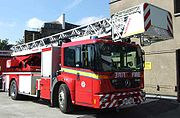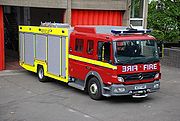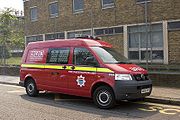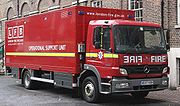
London Fire Brigade equipment
Encyclopedia
The London Fire Brigade
operates a large and diverse fleet of appliance
s, all carrying a variety of specialised equipment and apparatus for use in firefighting and rescue
operations.
The standard London fire engine has 13½ m and/or 9 m ladder extensions, eight 18 m lengths of hose
-reel tubing, four 23 m lengths of 45 mm hose, ten 23 m lengths of 70 mm hose, cutting equipment, a portable generator, a lightweight portable pump, water-packs, inflatable airbag
s, road signs, floodlight
s, a medical kit, hose ramps, general tools, chemical suit
s, breathing apparatus, and more. Fire stations with two DPLs, one will be a 'pump' and the other a 'pump ladder', both carrying a short extension ladder and cat ladder for climbing roofs. The pump carries the 9 m ladder, the pump ladder carries the 13.5 m, whilst the stations with only one DPL will carry both.
DPLs weigh around 11.2 tonnes, and are approximately 7.7 m long, 2.3 m wide and 3.2 m high. They carry up to 1,365 l of water, and have a pumping capacity of 3,910 l/min.
Between 2002 and 2007 a new fleet of 216 Mercedes-Benz Atego
vehicles were delivered to fire stations, training centres and driving schools throughout London with new TVAC/Plastisol bodywork. These replaced the existing fleet of older Volvo FL
6.14s with Saxon Sanbec bodywork.
All fire engines and fireboats also now carry first aid
equipment, including defibrillators. The introduction of first aid capability and training – known as Immediate Emergency Care (IEC) – mean that as part of normal duties firefighters attending incidents will be prepared to treat casualties who need immediate medical care until paramedics arrive to take over.

 The fleet consists of four TLs and seven ALPs, with five more ALPs kept spare as reserves, and one used at the Brigade's training centre.
The fleet consists of four TLs and seven ALPs, with five more ALPs kept spare as reserves, and one used at the Brigade's training centre.
The ALP platform can carry up to four firefighters and reach a height of 32 m; a monitor in the cage can deliver up to 2,400 l of water per minute.
 The FRUs are equipped with heavy lifting, winching, cutting and pulling tools, floodlighting, longer-duration breathing apparatus (vital for rescuing people from tunnels deep underground, for example), portable generators and other specialised equipment. FRU crews are specially trained and equipped to handle complex rescues, including those from road and rail accidents, water, mud and ice, urban search and rescue incidents such as collapsed buildings, chemical spills and difficult rescues at height.
The FRUs are equipped with heavy lifting, winching, cutting and pulling tools, floodlighting, longer-duration breathing apparatus (vital for rescuing people from tunnels deep underground, for example), portable generators and other specialised equipment. FRU crews are specially trained and equipped to handle complex rescues, including those from road and rail accidents, water, mud and ice, urban search and rescue incidents such as collapsed buildings, chemical spills and difficult rescues at height.
Nine of the Brigade's existing fleet of FRUs were successfully mobilised to the 7/7 bombings
and since then the LFB has upped its number of FRUs from ten (including one reserve) to sixteen.
 Command support units (CSU) will be summoned to any incident that has more than four fire crews on scene and is a vehicle from which senior officers can control the incident, and have the latest computer and radio technology fitted to allow them to do this, including two large plasma screens (one inside, one outside) for viewing footage or CCTV of the ongoing situation with a 6 m mast and generator.
Command support units (CSU) will be summoned to any incident that has more than four fire crews on scene and is a vehicle from which senior officers can control the incident, and have the latest computer and radio technology fitted to allow them to do this, including two large plasma screens (one inside, one outside) for viewing footage or CCTV of the ongoing situation with a 6 m mast and generator.
There are nine (one reserve) of these vehicles placed at strategic locations across London so that one can reach any incident within twenty minutes. A fundamental advantage of specialised CSUs is to accommodate the many different types of communication equipment needed at major incidents. In addition to the wide range of radio frequencies used, the brigade often need to communicate via landlines and mobile telephones, as well as send and receive information via satellite links and CCTV.
 Up until June 2010, Acton and East Ham stations each had two FIUs, while New Cross station had three. They have all now been moved to a Fire Investigation headquarters at Dowgate fire station in the City where they are all able to be mobilised citywide.
Up until June 2010, Acton and East Ham stations each had two FIUs, while New Cross station had three. They have all now been moved to a Fire Investigation headquarters at Dowgate fire station in the City where they are all able to be mobilised citywide.
In addition, Dowgate is also the base of the London Fire Brigade's fire investigation dog unit. This unique vehicle is manned by members of the Arson Response Team and can transport one of the brigade's four specially-trained search dogs.
At the scene of incidents, a fire investigation dog wears specialist protective 'fire wellies' on his or her paws to guard against injuries from broken glass or hot material. The dogs can detect minute quantities of hydrocarbon accelerants within minutes. This procedure would normally take a human fire investigator - using specialist equipment - hours before samples can be taken away for scientific evidence.
 New operational support units (OSU) became operational in 2008, each costing £43,800.
New operational support units (OSU) became operational in 2008, each costing £43,800.
Six of these vehicles are based at specially-designated operational support stations, being Ealing, Finchley, Lee Green, Stratford, Sutton and Wandsworth. A seventh OSU is stored as a reserve. The OSUs provide initial emergency attendance, taking specialist supporting equipment, such as a large quantity of breathing apparatus for example, to incidents.
A number of palletised and transferable loads are stored at the operational support stations. These pallets can then be requested by incident commanders as required, and would be loaded on to the OSU to be taken to the fireground.
The brigade may summon a BFU to incidents that require a large amount of foam for firefighting operations. An example would be a plane crash or chemical fire where a major foam attack would be undertaken.
The LFB currently operates three of these vehicles citywide, which are based at Barking, Finchley and Sutton fire stations. However, three new foam vehicles are under development to provide a new method of foam concentrate delivery to incidents. The vehicles will transport a variety of fuel firefighting media and application equipment in 1,000 l containers or on 1 tonne pallets. These are intended to be deployed individually from the transporter via a forklift truck, and transported around the fireground as required.
The vehicle houses large-capacity high-pressure hose wagons and responds to incidents where hydrants or other water sources are not close enough to the fireground and firefighters are hampered by a lack of water. The vehicle will lay out its hose at the nearest hydrant or open source then drive to the fireground with the hose laying off the back.
Upon arrival it will connect to a standard appliance to supply it with the water needed for the firefighting operations.
There are four of these citywide, based at Beckenham, Romford, Southgate and Richmond stations.
 An incident response unit (IRU) is a government-supplied decontamination vehicle that was introduced in the wake of the September 11 attacks as part of the New Dimension scheme for equipping UK brigades with extensive disaster response vehicles for any major catastrophe or terrorist attack.
An incident response unit (IRU) is a government-supplied decontamination vehicle that was introduced in the wake of the September 11 attacks as part of the New Dimension scheme for equipping UK brigades with extensive disaster response vehicles for any major catastrophe or terrorist attack.
A forklift truck is mounted on the rear of the lorry, and is used to remove the equipment cages from the curtain-side.
Equipment includes disrobe and rerobe packs for before and after casualty decontamination; 48 gastight suits; tent structures raised by hot-air blowers; decontamination showers powered by a water boiler and supplied by a submersible pump (decontaminated water is dammed); a telescopic lighting unit; mobile data transmission; GPS mapping and radiation monitoring devices.
 A high-volume pumping unit (HVPU) is a large fire appliance supplied by the government to UK fire brigades, as part of the New Dimension scheme to help better-equip the fire services to respond to large-scale disasters and terrorist attacks.
A high-volume pumping unit (HVPU) is a large fire appliance supplied by the government to UK fire brigades, as part of the New Dimension scheme to help better-equip the fire services to respond to large-scale disasters and terrorist attacks.
It carries a submersible pump, supplying water from any open source to the fireground, a generator that pumps up to 8,000 l/min (twice as much as a typical standard fire engine), a hose box module, and ancillary equipment.
London currently has nine of these HVPUs.
Outside of London, these vehicles proved invaluable in response to the UK floods in 2007
.
These include the IRU, HVPU and a range of other urban search and rescue (USAR) vehicles.
The first USAR "module" is primarily for building collapse rescue. It is a heavy-rescue truck carrying apparatus to gain access to and explore voids/spaces after a structural collapse, as well as binoculars, digital cameras, core drills, electrical tools, angle grinders, search cameras, communications equipment, life detectors, timber cutters, and lighting.
Another type of USAR module is a truck carrying a multi-purpose vehicle for removing debris from a disaster site and disposing of this onto the truck. It also carries a large inflatable tent for sheltering equipment.
Finally, a flatbed lorry carrying 10 tonnes of C16-grade timber can used to support unstable structures that may collapse.
 Purchased in late 2005 following the 7/7 suicide bombings, an SSU can attend a wide range of incidents, including chemical spills and fires, where early on-site scientific analysis and monitoring will speed up the detection process and allow the Brigade and other emergency services to provide the correct response for the particular incident.
Purchased in late 2005 following the 7/7 suicide bombings, an SSU can attend a wide range of incidents, including chemical spills and fires, where early on-site scientific analysis and monitoring will speed up the detection process and allow the Brigade and other emergency services to provide the correct response for the particular incident.
Until their arrival, the brigade had not been able to adequately undertake enhanced scientific analysis for chemical, biological and radiological testing at the scene. These durable and future-proof vehicles are fully upgraded to respond to a range of incidents including those where forensic fire investigators request the use of a mobile facility to enhance both public and firefighter safety.
The only two of these vehicles in the brigade are stationed at Poplar and Hammersmith.
s are called Fireflash and Firedart, both based at the Lambeth River station. Firedart is used in daily operation, while Fireflash is reserved for training exercises and a spare.
They are used for a variety of incidents, such as people stranded in the River Thames, fires on boats, crashed boats, and riverside property on fire.
London Fire Brigade
The London Fire Brigade is the statutory fire and rescue service for London.Founded in 1865, it is the largest of the fire services in the United Kingdom and the fourth-largest in the world with nearly 7,000 staff, including 5,800 operational firefighters based in 112 fire...
operates a large and diverse fleet of appliance
Fire apparatus
A fire apparatus, fire engine, fire truck, or fire appliance is a vehicle designed to assist in fighting fires by transporting firefighters to the scene and providing them with access to the fire, along with water or other equipment...
s, all carrying a variety of specialised equipment and apparatus for use in firefighting and rescue
Rescue
Rescue refers to responsive operations that usually involve the saving of life, or prevention of injury during an incident or dangerous situation....
operations.
Dual-purpose ladder
The dual-purpose ladder (DPL) is the standard vehicle deployed to all emergency calls by the London Fire Brigade. There are approximately 170 in operation across the city.The standard London fire engine has 13½ m and/or 9 m ladder extensions, eight 18 m lengths of hose
Fire hose
A fire hose is a high-pressure hose used to carry water or other fire retardant to a fire to extinguish it. Outdoors, it is attached either to a fire engine or a fire hydrant. Indoors, it can be permanently attached to a building's standpipe or plumbing system...
-reel tubing, four 23 m lengths of 45 mm hose, ten 23 m lengths of 70 mm hose, cutting equipment, a portable generator, a lightweight portable pump, water-packs, inflatable airbag
Airbag
An Airbag is a vehicle safety device. It is an occupant restraint consisting of a flexible envelope designed to inflate rapidly during an automobile collision, to prevent occupants from striking interior objects such as the steering wheel or a window...
s, road signs, floodlight
High-intensity discharge lamp
High-intensity discharge lamps are a type of electrical lamp which produces light by means of an electric arc between tungsten electrodes housed inside a translucent or transparent fused quartz or fused alumina arc tube. This tube is filled with both gas and metal salts. The gas facilitates the...
s, a medical kit, hose ramps, general tools, chemical suit
NBC suit
An NBC suit is a type of military personal protective equipment designed to provide protection against direct contact with and contamination by radioactive, biological or chemical substances, and provides protection from contamination with radioactive materials and some types of radiation,...
s, breathing apparatus, and more. Fire stations with two DPLs, one will be a 'pump' and the other a 'pump ladder', both carrying a short extension ladder and cat ladder for climbing roofs. The pump carries the 9 m ladder, the pump ladder carries the 13.5 m, whilst the stations with only one DPL will carry both.
DPLs weigh around 11.2 tonnes, and are approximately 7.7 m long, 2.3 m wide and 3.2 m high. They carry up to 1,365 l of water, and have a pumping capacity of 3,910 l/min.
Between 2002 and 2007 a new fleet of 216 Mercedes-Benz Atego
Mercedes-Benz Atego
The Mercedes-Benz Atego is a range of light rigid truck introduced by Mercedes-Benz in 1997.Designated 970, it is available in weights of 7.5 to 16 metric tonnes and is powered by a straight 4 or 6 cylinder engine...
vehicles were delivered to fire stations, training centres and driving schools throughout London with new TVAC/Plastisol bodywork. These replaced the existing fleet of older Volvo FL
Volvo FL
The Volvo FL is Volvo's smallest truck and is suitable for local and regional distribution operations, refuse collection, construction truck or small format tractor...
6.14s with Saxon Sanbec bodywork.
All fire engines and fireboats also now carry first aid
First aid
First aid is the provision of initial care for an illness or injury. It is usually performed by non-expert, but trained personnel to a sick or injured person until definitive medical treatment can be accessed. Certain self-limiting illnesses or minor injuries may not require further medical care...
equipment, including defibrillators. The introduction of first aid capability and training – known as Immediate Emergency Care (IEC) – mean that as part of normal duties firefighters attending incidents will be prepared to treat casualties who need immediate medical care until paramedics arrive to take over.
Aerial appliances
The LFB uses two main types of aerial appliances, the aerial ladder platform (ALP) and turntable ladder (TL), for high-rise rescues, aerial water dousing and other requirements.

The ALP platform can carry up to four firefighters and reach a height of 32 m; a monitor in the cage can deliver up to 2,400 l of water per minute.
Fire rescue unit
A fire rescue unit (FRU) is a special type of rescue vehicle used by the London Fire Brigade.
Nine of the Brigade's existing fleet of FRUs were successfully mobilised to the 7/7 bombings
7 July 2005 London bombings
The 7 July 2005 London bombings were a series of co-ordinated suicide attacks in the United Kingdom, targeting civilians using London's public transport system during the morning rush hour....
and since then the LFB has upped its number of FRUs from ten (including one reserve) to sixteen.
Command support unit

There are nine (one reserve) of these vehicles placed at strategic locations across London so that one can reach any incident within twenty minutes. A fundamental advantage of specialised CSUs is to accommodate the many different types of communication equipment needed at major incidents. In addition to the wide range of radio frequencies used, the brigade often need to communicate via landlines and mobile telephones, as well as send and receive information via satellite links and CCTV.
Fire investigation unit
A fire investigation unit (FIU) generally attends fires and incidents where the cause is thought to be suspicious, and is crewed by specially-trained experts, acting in assistance to police investigations.
In addition, Dowgate is also the base of the London Fire Brigade's fire investigation dog unit. This unique vehicle is manned by members of the Arson Response Team and can transport one of the brigade's four specially-trained search dogs.
At the scene of incidents, a fire investigation dog wears specialist protective 'fire wellies' on his or her paws to guard against injuries from broken glass or hot material. The dogs can detect minute quantities of hydrocarbon accelerants within minutes. This procedure would normally take a human fire investigator - using specialist equipment - hours before samples can be taken away for scientific evidence.
Operational support unit

Six of these vehicles are based at specially-designated operational support stations, being Ealing, Finchley, Lee Green, Stratford, Sutton and Wandsworth. A seventh OSU is stored as a reserve. The OSUs provide initial emergency attendance, taking specialist supporting equipment, such as a large quantity of breathing apparatus for example, to incidents.
A number of palletised and transferable loads are stored at the operational support stations. These pallets can then be requested by incident commanders as required, and would be loaded on to the OSU to be taken to the fireground.
Bulk foam unit
A bulk foam unit (BFU) is a demountable pod carrying a 3,000 l foam tank and twenty 25 l foam cans.The brigade may summon a BFU to incidents that require a large amount of foam for firefighting operations. An example would be a plane crash or chemical fire where a major foam attack would be undertaken.
The LFB currently operates three of these vehicles citywide, which are based at Barking, Finchley and Sutton fire stations. However, three new foam vehicles are under development to provide a new method of foam concentrate delivery to incidents. The vehicles will transport a variety of fuel firefighting media and application equipment in 1,000 l containers or on 1 tonne pallets. These are intended to be deployed individually from the transporter via a forklift truck, and transported around the fireground as required.
Hose layer unit
Hose layer units (HLU) are demountable pods mounted on Volvo chassis.The vehicle houses large-capacity high-pressure hose wagons and responds to incidents where hydrants or other water sources are not close enough to the fireground and firefighters are hampered by a lack of water. The vehicle will lay out its hose at the nearest hydrant or open source then drive to the fireground with the hose laying off the back.
Upon arrival it will connect to a standard appliance to supply it with the water needed for the firefighting operations.
There are four of these citywide, based at Beckenham, Romford, Southgate and Richmond stations.
Incident response unit

A forklift truck is mounted on the rear of the lorry, and is used to remove the equipment cages from the curtain-side.
Equipment includes disrobe and rerobe packs for before and after casualty decontamination; 48 gastight suits; tent structures raised by hot-air blowers; decontamination showers powered by a water boiler and supplied by a submersible pump (decontaminated water is dammed); a telescopic lighting unit; mobile data transmission; GPS mapping and radiation monitoring devices.
High-volume pumping unit

It carries a submersible pump, supplying water from any open source to the fireground, a generator that pumps up to 8,000 l/min (twice as much as a typical standard fire engine), a hose box module, and ancillary equipment.
London currently has nine of these HVPUs.
Outside of London, these vehicles proved invaluable in response to the UK floods in 2007
2007 United Kingdom floods
The 2007 United Kingdom floods were a series of destructive floods that occurred in various areas across the country during the summer of 2007. The most severe floods occurred across Northern Ireland on 12 June; East Yorkshire and The Midlands on 15 June; Yorkshire, The Midlands, Gloucestershire,...
.
Urban search and rescue
As part of the New Dimension scheme a range of specialised fire and rescue vehicles were supplied to fire brigades around the UK.These include the IRU, HVPU and a range of other urban search and rescue (USAR) vehicles.
The first USAR "module" is primarily for building collapse rescue. It is a heavy-rescue truck carrying apparatus to gain access to and explore voids/spaces after a structural collapse, as well as binoculars, digital cameras, core drills, electrical tools, angle grinders, search cameras, communications equipment, life detectors, timber cutters, and lighting.
Another type of USAR module is a truck carrying a multi-purpose vehicle for removing debris from a disaster site and disposing of this onto the truck. It also carries a large inflatable tent for sheltering equipment.
Finally, a flatbed lorry carrying 10 tonnes of C16-grade timber can used to support unstable structures that may collapse.
Scientific support unit
Scientific Support Units (SSU) are specialised vehicles carrying a vast amount of chemical monitoring equipment.
Until their arrival, the brigade had not been able to adequately undertake enhanced scientific analysis for chemical, biological and radiological testing at the scene. These durable and future-proof vehicles are fully upgraded to respond to a range of incidents including those where forensic fire investigators request the use of a mobile facility to enhance both public and firefighter safety.
The only two of these vehicles in the brigade are stationed at Poplar and Hammersmith.
Fireboat
London's two fireboatFireboat
A fireboat is a specialized watercraft and with pumps and nozzles designed for fighting shoreline and shipboard fires. The first fireboats, dating to the late 18th century, were tugboats, retrofitted with firefighting equipment....
s are called Fireflash and Firedart, both based at the Lambeth River station. Firedart is used in daily operation, while Fireflash is reserved for training exercises and a spare.
They are used for a variety of incidents, such as people stranded in the River Thames, fires on boats, crashed boats, and riverside property on fire.

